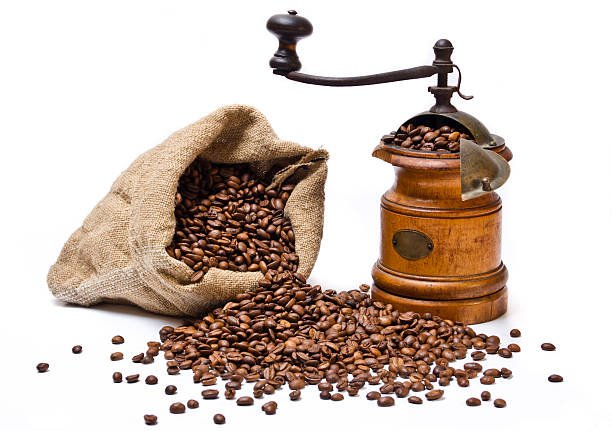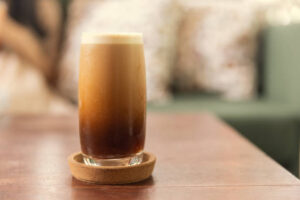Ah, the magic of coffee. That rich aroma that fills the air, the promise of a delicious pick-me-up, and the comforting ritual of brewing a cup. But there’s a crucial step that often gets overlooked: the grind. Just like you wouldn’t use chunky salsa for a delicate fish taco, the grind size of your coffee beans significantly impacts the final taste. So, fellow coffee enthusiasts, let’s delve into the fascinating world of coffee bean grinding, transforming us from caffeine consumers to coffee connoisseurs.
Table of contents
From Bean to Brew: Unveiling the Grind Spectrum
Imagine a spectrum, with coarse grinds on one end and fine grinds on the other. Each step along this spectrum changes how water interacts with the coffee, ultimately shaping the flavor profile of your cup. Here’s a breakdown of the key grind sizes:

Coarse Grind (French Press, Cold Brew):
Picture chunky sea salt. This coarse grind is ideal for brewing methods like the French Press or cold brew, where water has longer contact time with the grounds. Think of it like letting tea leaves steep – a coarse grind allows for slower extraction, resulting in a smoother, less intense cup.
Medium Grind (Drip Coffee, Pour-Over):
Think of beach sand. This medium grind is the workhorse of the coffee world, perfect for automatic drip coffee makers and pour-over methods. It strikes a balance between extraction time and flavor intensity, delivering a well-rounded cup.
Medium-Fine Grind (AeroPress):
Imagine finely ground black pepper. This grind size is slightly finer than medium, ideal for the AeroPress, which uses a pressurized brewing method. Think of it like steeping tea in a teabag – the finer grind allows for faster extraction, resulting in a stronger, more full-bodied cup.
Koffee Kult Dark Roast And Medium Roast Coffee Beans

- Great for drip and espresso brew methods
- 100% Arabica coffee beans
- Economy pack
Fine Grind (Espresso):
Picture powdered sugar. This super fine grind is reserved for espresso machines, where hot water passes through the grounds under high pressure. Think of it like squeezing juice out of an orange – the fine grind ensures maximum extraction for a concentrated, bold shot of espresso.
Matching Grind to Method: The Recipe for Perfection
Just like a perfectly crafted recipe, the grind size is an essential ingredient for brewing the coffee you love. Here’s a quick guide to help you match your grind to your brewing method:
- French Press: Coarse grind for a smooth, flavorful cup.
- Drip Coffee Maker: Medium grind for a balanced and satisfying brew.
- Pour-Over: Medium grind for a nuanced and complex coffee experience.
- AeroPress: Medium-fine grind for a strong and full-bodied coffee.
- Espresso Machine: Fine grind for a concentrated and intense espresso shot.
Beyond the Basics: Exploring Grind Nuances
The world of coffee grinding is more than just a coarse, medium, fine checklist. Here are some additional factors to consider:
- Freshness Matters: Freshly roasted beans are more forgiving of grind size variations. Stale beans, however, can benefit from a slightly finer grind for better extraction.
- Personal Preference: Ultimately, the perfect grind is the one that tastes best to you! Experiment with different grind sizes within a range suitable for your brewing method and discover your flavor sweet spot.

The Grind Ritual: Tools and Techniques
Now, let’s talk tools. There are several ways to achieve the perfect grind:
- Burr Grinder: Our champion grinder, featuring two burrs that crush beans between them, delivering consistent and precise results. Think of it like a high-quality food processor specifically designed for coffee beans.
- Blade Grinder: A more budget-friendly option, but it can create uneven grinds. Imagine chopping vegetables with a dull knife – you might end up with a mix of large chunks and fine particles. Blade grinders are best suited for coarser grinds.
- Pre-Ground Coffee: A convenient option, but remember, freshness takes a hit. If you choose pre-ground coffee, aim for small quantities and store them in an airtight container.
Grinding Tips for the Coffee Aficionado
- Grind Just Before Brewing: Freshly ground coffee releases the most vibrant flavors. Think of freshly cracked pepper – it adds a much more intense kick compared to pre-ground pepper.
- Start Coarse and Adjust: If you’re unsure, begin with a slightly coarser grind and adjust based on your taste. A finer grind can lead to over-extraction and bitterness, while a coarse grind can result in a weak and under-extracted cup.
- Cleanliness is Key: Regularly clean your grinder to remove any residual coffee oils that can affect flavor and consistency. Imagine a paintbrush coated in dried paint – it won’t apply fresh paint evenly
pen_spark
Beyond the Grind: Brewing Bliss Awaits
Now that you’ve mastered the art of grinding, let’s explore how this newfound knowledge translates into brewing bliss. Here are some additional tips to elevate your coffee experience:
- Invest in Quality Beans: Just like using high-quality ingredients elevates a dish, freshly roasted, specialty-grade coffee beans will unlock a world of flavor potential. Think of the difference between store-bought tomatoes and vine-ripened ones from a farmer’s market – the fresher the ingredients, the more vibrant the taste.
- Water Matters: Water makes up the majority of your coffee, so don’t underestimate its importance. Filtered or spring water is ideal, as tap water can introduce unwanted flavors and minerals. Imagine brewing tea with rusty water – it wouldn’t be very pleasant!
- The Golden Ratio: A good starting point for most brewing methods is a 1:16 coffee-to-water ratio. This means using one gram of coffee for every 16 grams of water. Of course, this can be adjusted to your taste preference – stronger coffee lovers can use a slightly higher ratio.
- Experiment and Explore: The beauty of coffee is its versatility. With your newfound grinding skills, you can now experiment with different brewing methods, bean origins, and roast profiles. Think of it like mastering a basic cooking technique and then branching out to create new and exciting dishes. There’s a whole world of coffee experiences waiting to be discovered!
From Bean to Cup: A Journey of Discovery
By embracing the art of the grind, you’ve taken a significant step towards becoming a coffee connoisseur. You’ve unlocked the power to transform those little green beans into a symphony of flavor and aroma in your cup. Remember, the journey doesn’t end here. Continue experimenting, refining your technique, and discovering the perfect cup that speaks to your taste buds. After all, coffee is more than just a beverage – it’s a ritual, a source of energy, and a way to connect with the world around us. So, grab your grinder, choose your beans, and embark on your own delightful coffee adventure!






